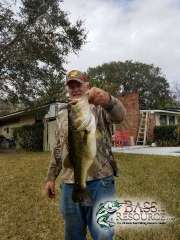Good Day All,
Hope you’re all able to enjoy family and friends during this Holiday Season. During my time away from professional responsibilities I’ve been able to explore a number of angling related topics with one on soft split rings to share.
Here in Arizona we’ve had a mix of weather mostly great for getting out an taunting fish. Many of the lakes / ponds are stocked with trout during the cold months so my angling fun is expanded. I’m happy with simply catching fish primarily bass and sunfish but grateful for any fun on lite tackle.
Recent events have restricted my time out on the water so I’ve changed focus to learning and testing out a few new knots. I generally use between two to six pound line. I’ve been looking for ease of tying, sufficient strength, and minimal waste. So in goofing off doing all this research and trying out the various knots using old residual stock of various fishing lines, I fell into the rabbit hole, distraction, of learning about soft split rings. I had remnant spools of ancient braid or braid I collected with intentions of reuse. Originally I used those remnants for fly tying or leader material. I figured it was more than I wanted to simply discard and it could be used otherwise.
Reviewing a number of articles and videos on why use soft split rings, exchanging the connection between bait and hook with short segment of braid. This allows the hook to move with greater freedom independent of the lure body. The principle benefit is to minimize leverage or binding from the limited range of motion with a wire split ring. I wanted to see if it would improve hook up ratio where it would be harder the fish to throw the lure once connected.
Using heavier fishing equipment it is possible to overwhelm a hooked fish by hauling it in aggressively to minimize thrashing and potential to throw the hook. There is only so much of that persuasion with lighter fishing rigs. So it was worth my attention to give it a try.
I worked up several brands of small metal spoon type lures. I’ve used them successfully for bass, bluegills, and trout. I removed the split ring and replaced it with a segment of braid to re-connect the original treble hook. I did work some up some with single octopus hooks too. The result was a short pig tail segment of braid, roughly a 0.5 inch , 1 cm or less in length between hook and lure body.
My initial findings were impressively encouraging. Using the newly configured metal spoon baits, I caught and released nine trout in a couple of hours of walking and casting at one of the regional parks. None of the trout threw the baits even with the aerial antics of jumping completely out of the water. All I did was simply keep reasonable tension with the ultra lite rig. All were nicely nose hooked in the tip of the upper lip. Sure fun to experience the smash and grab action on ultra lite rigs.
I’m happy I took the time to investigate this new option. I hope to expand it to other larger hard baits, crank baits, and jerk baits when using these heavier rigs. It must be providence as while was taunting trout, I recovered a floating jerk bait body along the shoreline in some weeds. The hooks were corroded away, so it will be the next re-build effort.
I found a variety of hemostats to be really helpful in fabricating these soft split ring segments. There are a number of on line videos out there. I watched a few and settled on one version that was more elegant, easier to tie, with minimal material. I did my best to keep the link no longer than a centimeter. Be well, cheers!

.thumb.jpg.df52404fc648bc17a641a50eb4c9dac9.jpg)

.thumb.jpg.d431b5daa6ef35470410602b9be6f3ae.jpg)
